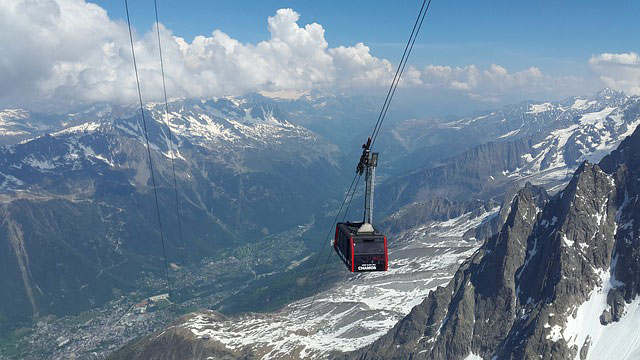 Situated at the base of Mont Blanc, the iconic resort town of Chamonix is known for its skiing and jaw-dropping views. But there’s something else this popular tourist destination is becoming known for: pollution.
Situated at the base of Mont Blanc, the iconic resort town of Chamonix is known for its skiing and jaw-dropping views. But there’s something else this popular tourist destination is becoming known for: pollution.
Despite its high elevation, Chamonix – and much of the l’Arve Valley – has some of the highest levels of pollution in all of France.
As one of the oldest ski resorts in the country, the Chamonix’s idyllic location makes it a haven for skiers, outdoor lovers and climbing enthusiasts. What people don’t see is the industrial area of Passy in the valley below or the heavy traffic that now runs through the area day in and day out.
While these factors contribute to the problem, the valley’s “V” shape is both a boon and bane for Chamonix. It provides breathtaking vides, but that V-shape makes the valley encased. And when high pressure systems move through, it traps pollution in the valley.
The steep mountain sides, significant temperature differences and deep valleys trap pollutants in the valley floor, particularly on sunny winter days when the air is still.
The largest source of pollution in the valley comes from residential homes, which produces fine particles from heating. Nitrogen dioxide from traffic is another big problem for this resort town.
About 60-80% of the fine-particle pollution in the area comes from wood-burning stoves and fireplaces in homes.
Fine and ultra-fine particles, the type that gets right into your lungs, does the most damage. Fine particle levels are dangerously high about 40 days out of the year.
But there’s another pollutant, a cancerous organic compound, that’s quickly reaching concerning levels: Benzo(a)pyrene, or BaP.
All of these pollutants are regulated by European laws, and the valley often exceeds daily limits. Alarms are raised when those levels become critical. At that point, people are discouraged from engaging in physical activity.
Sport activities in schools are canceled. Kids are given blocks and cards to play with at break time to keep them from moving too much.
Locals in the valley below complain of suffering from respiratory illnesses and coughs that just won’t go away.
Pollution has long been a problem in Chamonix and the l’Arve Valley as a whole. People outside the valley are just now starting to take notice.
The problem truly became clear in the early 2000s. The Mont Blanc Tunnel was closed in 1999 following a truck fire. The air quality improved dramatically. According to reports, wildflowers appeared that hadn’t been seen in years, and the entrance to tunnel – typically blackened by fumes – became a “pearly white.”
Chamonix is well aware of its pollution problem, and is already taking steps to resolve the problem.
One major step that Chamonix took towards reducing pollution is making all public transport free for both residents and visitors. The move to make public transport free costs the municipality five million euros per year, but has tripled the number of people using the system each year.
A project is already underway to improve Chamonix’s rail system. Right now, taking the train to Chamonix is complicated, with many stops and long wait times. Grade Geneve, as it’s called, aims to improve the rail system to make the municipality more accessible via train.
For residents, a local fund is offering to finance 20% of renovation projects. Tax breaks are also available to locals who install eco-friendly heating systems. Many of the local public buildings have also been renovated.
Despite all of these efforts, there is one major source of pollution that Chamonix has little control over: heavy goods vehicles (HGV).
 Half a million HGV vehicles pass through the Mont Blanc Tunnel each year. But improvements are also being made here to help limit the environmental impact of these vehicles. Today, 94% of HGV trips are made using eco-friendly lorries.
Half a million HGV vehicles pass through the Mont Blanc Tunnel each year. But improvements are also being made here to help limit the environmental impact of these vehicles. Today, 94% of HGV trips are made using eco-friendly lorries.
Still, it will take time for the effects of these efforts to be seen. Should you let pollution keep you away from this skiing mecca? No. Chamonix’s mayor says pollution is not a significant problem up on the lifts.
Should you ditch the open fire and trade in your rental car for the bus? Yes. If every tourist made these small changes, the impact on lowering pollution could be huge.